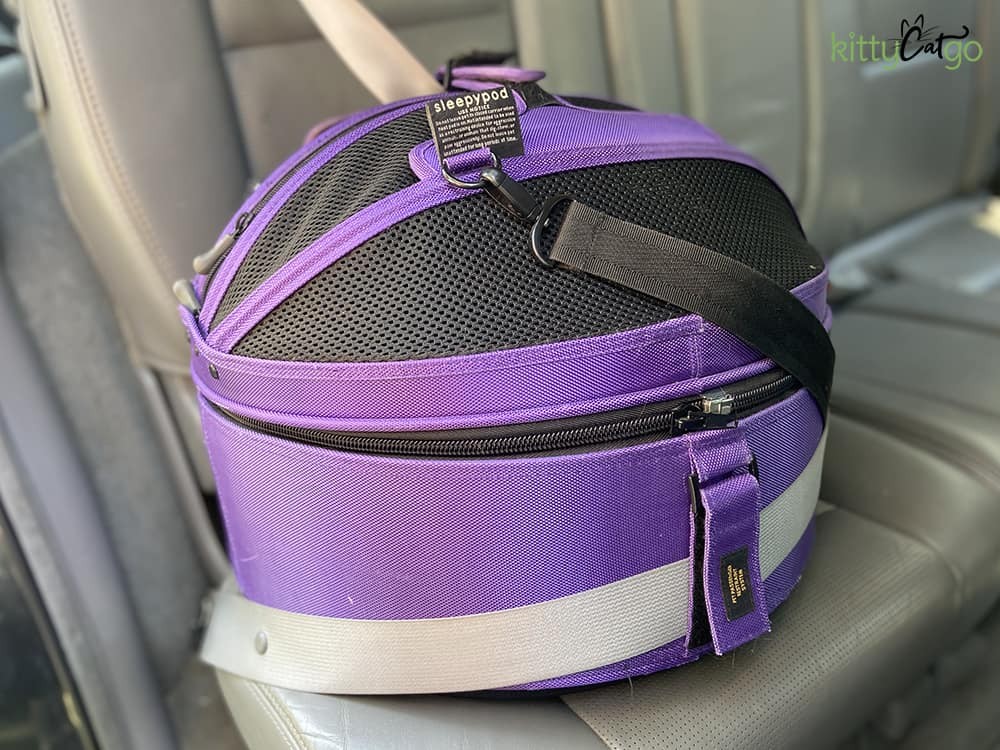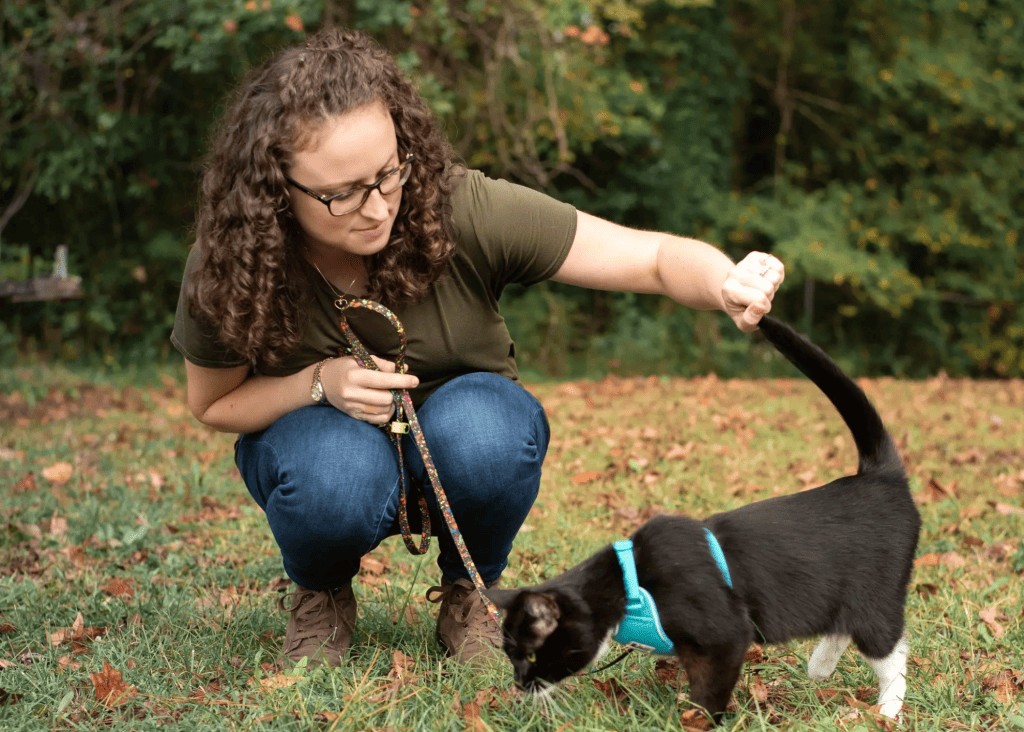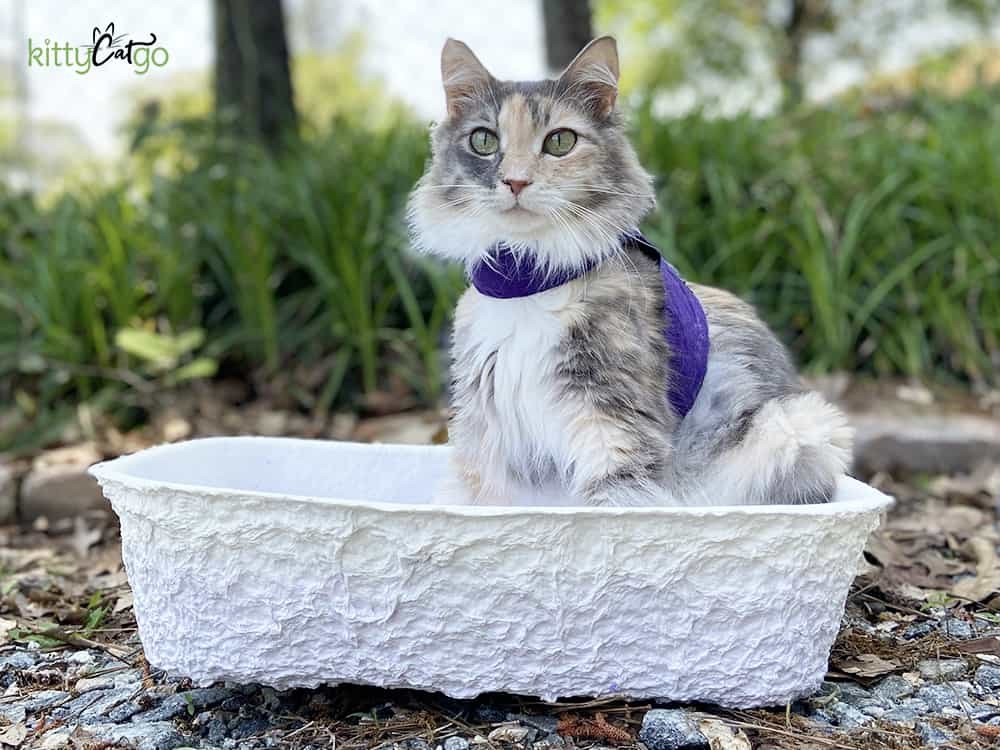Traveling with your feline friend in the car may seem daunting, but with proper planning and preparation, it can be a fun and rewarding experience. At TRAVELS.EDU.VN, we’re dedicated to providing you with expert advice and resources to ensure a smooth and stress-free journey for both you and your beloved cat. Discover essential cat travel tips, including carrier selection, pre-trip preparation, and in-transit care, ensuring a comfortable and secure road trip for your furry companion.
1. Planning a Purr-fect Cat Road Trip
Traveling long distances with cats requires more than just packing up and hitting the road. Proper planning is crucial to ensure a comfortable and safe journey for both you and your feline companion.
1.1. Selecting a Safe and Comfortable Cat Carrier
A carrier is essential for your cat’s safety while traveling in the car. Regardless of your cat’s behavior, a carrier provides the best protection in case of sudden braking or accidents.
Consider the Sleepypod Mobile Pet Bed. This carrier doubles as a cat bed, allowing your cat to travel in familiar comfort. It features a mesh-dome top for visibility and has been crash-tested for safety. It can be strapped in with a seatbelt and has proven to hold up in car accidents.
 Sleepypod carrier for cat road trips
Sleepypod carrier for cat road trips
If you need something more spacious, especially for longer trips, the Pet Fit for Life carrier is a viable option. While lacking the Sleepypod’s safety features, it can be secured with a seatbelt and provides ample room for your cat to stretch. The large size can accommodate two cats and includes a portable litter box.
1.2. Practicing Short Drives Before a Long Trip
If your cat is not used to car rides, gradually introduce them to the experience. Start with short drives around the block, gradually increasing the distance. This will help them become accustomed to the motion and sounds of the car. The Humane Society suggests familiarizing your cat with the car environment slowly to reduce stress.
Carrier Tip: Leave the carrier in your home so your cat can explore it. Feeding them in the carrier can help them associate it with positive experiences, making it a safe and comfortable space.
1.3. Verifying Up-to-Date Identification Tags
Ensure your cat’s ID tags are current before your trip. This is crucial in case your cat gets lost. Consider microchipping your cat for added security. According to the American Veterinary Medical Association (AVMA), microchipping significantly increases the chances of reuniting lost pets with their owners.
 Woman with cat outside on a harness and leash
Woman with cat outside on a harness and leash
1.4. Reserving Cat-Friendly Accommodations in Advance
Finding accommodations that welcome cats can be challenging. Making reservations ahead of time ensures you have a suitable place to stay.
Always confirm that the accommodation is cat-friendly. Many places advertise as “pet-friendly” but only cater to dogs. Contact the hotel or rental directly to confirm their cat policy and inquire about any additional fees.
1.5. Planning for Litter Box Needs During the Trip
For road trips longer than a couple of hours, you’ll need a litter box plan. There are a few options:
- Place a small litter box inside the carrier, if it’s large enough.
- Line the carrier with pee pads for accidents.
- If your cat is leash-trained, allow them to use the bathroom outside during stops.
Remember, your cat might not use the litter box in the car. Be prepared with multiple plans, like combining a litter box with pee pads.
 Disposable litter box for cat travel
Disposable litter box for cat travel
1.6. Creating a Cat Travel Packing List
Cats need more than just food and water when traveling. A comprehensive packing list ensures you don’t forget essential items.
Essential items to include:
- Food and water bowls
- Litter box and litter
- Dustpan and broom
- Trash bags
- Can opener (if needed)
- Extra food and litter
- Medications
- Favorite toys
- Blanket or bed
- First-aid kit
A detailed packing list helps you stay organized and prepared for any situation during your cat’s road trip.
2. What to Do on the Day of Your Cat’s Trip
On the day of your trip, take these steps to ensure a smooth start to your cat’s journey.
2.1. Avoid Feeding Your Cat Before the Trip
To minimize the risk of nausea or vomiting, avoid feeding your cat several hours before you leave. They can eat when you reach your destination.
2.2. Administer Necessary Medications as Prescribed
If your cat is prone to motion sickness or anxiety, consult your veterinarian. They can recommend or prescribe appropriate medications to help your cat stay calm and comfortable. Always follow your vet’s instructions and never give your cat medication without professional advice.
2.3. Provide Exercise Before Departure
Before hitting the road, engage your cat in a play session to tire them out. A tired cat is more likely to rest quietly during the car ride, reducing stress and potential issues.
2.4. Encourage Your Cat to Use the Litter Box
Encourage your cat to use the litter box before getting in the car. While you can’t force them, putting them in the litter box may prompt them to go.
3. Hitting the Road with Your Cat Safely
With all the preparation complete, it’s time to embark on your road trip. Here are some essential tips to ensure a safe and comfortable journey with your feline companion.
3.1. Keep Essential Items Accessible
Pack a bag with your cat’s necessities within easy reach. This includes water, treats, medication, pee pads, and anything else you might need quickly while on the road.
3.2. Plan Regular Pit Stops
For longer trips, plan to stop every few hours. This allows your cat to drink, use the bathroom, and stretch their legs. If your cat is harness and leash trained, take them for a short walk. If not, let them out of the carrier to roam the car briefly before continuing.
3.3. Never Leave Your Cat Unattended in the Car
Never leave your cat unattended in the car, especially in extreme weather. Temperatures inside a car can rise rapidly, posing a serious risk of heatstroke.
If you need to use the restroom and are traveling alone, bring two sets of car keys. This allows you to leave the car running with the air conditioning on while you’re away. If you don’t have a spare set, cool the car down before leaving your cat for a quick stop.
Leaving your cat unattended in a vehicle can have fatal consequences, as the American Society for the Prevention of Cruelty to Animals (ASPCA) warns.
4. Managing Cat Anxiety During Car Travel
Many cats experience anxiety during car rides. Understanding and addressing this anxiety is crucial for a smoother journey.
4.1. Recognize Signs of Anxiety in Cats
Common signs of anxiety include:
- Excessive vocalization
- Panting
- Restlessness
- Trembling
- Drooling
- Trying to escape the carrier
4.2. Use Calming Aids
Several products can help calm anxious cats:
- Pheromone Sprays: Feliway Classic Spray mimics natural feline pheromones and can reduce stress-related behaviors.
- Calming Treats: Many calming treats contain ingredients like L-theanine and chamomile, which have relaxing effects.
- Anxiety Vests: ThunderShirt applies gentle pressure, which can help calm anxious cats.
4.3. Create a Comfortable Environment
A comfortable environment can significantly reduce anxiety:
- Line the carrier with a soft blanket or bed.
- Include familiar toys or items that smell like home.
- Cover the carrier with a blanket to create a darker, more secure space.
4.4. Speak in a Soothing Voice
Your voice can have a calming effect on your cat. Talk to them in a gentle, reassuring tone throughout the trip.
4.5. Consider Professional Help
If your cat’s anxiety is severe, consult your veterinarian or a certified cat behaviorist. They can provide additional strategies or prescribe medication to help manage your cat’s anxiety.
5. Addressing Common Cat Travel Issues
Even with the best preparation, you may encounter some common issues while traveling with your cat.
5.1. Motion Sickness
Some cats experience motion sickness. If your cat vomits or drools excessively, it may be a sign of motion sickness.
- Prevention: Avoid feeding your cat before the trip and consult your vet about anti-nausea medications.
- During the Trip: Stop frequently for fresh air and keep the car cool.
5.2. Litter Box Accidents
Accidents can happen, especially during long trips.
- Prevention: Line the carrier with pee pads and offer frequent bathroom breaks.
- During the Trip: Clean up accidents immediately using enzymatic cleaners to eliminate odors.
5.3. Escape Attempts
Cats may try to escape the carrier, especially if they are anxious.
- Prevention: Use a secure carrier and keep it closed at all times.
- During the Trip: If you need to open the carrier, do so in a secure location where your cat cannot escape.
6. Expert Tips for Long Distance Cat Travel
For long distance travel, additional planning and considerations are necessary.
6.1. Extended Comfort
Ensure your cat’s carrier is spacious enough for longer trips. Consider larger carriers or even small dog crates that allow room for a litter box, food, and water.
6.2. Hydration Strategies
Keeping your cat hydrated is crucial, especially on long journeys.
- Water Bowls: Use spill-proof water bowls to prevent messes.
- Hydrating Food: Offer wet food to increase water intake.
- Frequent Breaks: Provide water during every pit stop.
6.3. Overnight Stays
When planning overnight stays, ensure the accommodations are cat-friendly and safe.
- Room Security: Inspect the room for potential hazards and secure any escape routes.
- Litter Box Setup: Set up the litter box in a quiet area.
- Comfort Items: Bring familiar items to help your cat feel secure.
6.4. Documentation
Keep your cat’s health records and vaccination certificates with you. This is important for crossing state lines or in case of a veterinary emergency.
6.5. Emergency Kit
Prepare an emergency kit with essential supplies:
- First-aid supplies
- Medications
- Food and water
- Blanket
- Litter box and litter
- Contact information for your veterinarian
7. Why Choose TRAVELS.EDU.VN for Your Cat Travel Needs?
At TRAVELS.EDU.VN, we understand the unique challenges of traveling with cats. Our comprehensive resources and personalized services ensure a stress-free journey for you and your feline companion.
7.1. Expert Guidance
Our team of travel experts provides reliable, up-to-date information on all aspects of cat travel. We offer tailored advice to meet your specific needs and concerns.
7.2. Cat-Friendly Accommodation Recommendations
We have an extensive network of cat-friendly accommodations, ensuring you find the perfect place to stay. Our recommendations are based on thorough research and customer feedback.
7.3. Customized Travel Planning
We offer personalized travel planning services to help you create the perfect itinerary for your trip. From route planning to activity suggestions, we handle all the details.
7.4. 24/7 Support
Our customer support team is available 24/7 to assist you with any questions or concerns. We are committed to providing exceptional service and ensuring your trip is a success.
8. Customer Success Stories
Don’t just take our word for it. Here are some testimonials from satisfied customers who have used TRAVELS.EDU.VN for their cat travel needs.
8.1. Sarah’s Story
“I was so nervous about traveling with my cat, Whiskers, but TRAVELS.EDU.VN made it so easy. They helped me find the perfect cat-friendly hotel and provided invaluable tips for managing his anxiety. I couldn’t have done it without them.”
8.2. John’s Experience
“TRAVELS.EDU.VN took the stress out of planning my cross-country road trip with my cat, Max. Their expert advice and customized itinerary ensured we had a smooth and enjoyable journey. I highly recommend their services.”
9. Essential Products for Car Travel with Cats
Equipping yourself with the right products can make a significant difference in the comfort and safety of your cat during car travel.
9.1. Premium Cat Carriers
Choose a carrier that provides both safety and comfort. Look for features like crash-tested designs, ventilation, and easy access.
9.2. Travel Litter Boxes
Portable litter boxes are essential for long trips. Consider disposable options or compact, foldable designs.
9.3. Spill-Proof Bowls
Prevent messes with spill-proof water and food bowls. These bowls are designed to minimize spills and keep your car clean.
9.4. Calming Aids
Stock up on calming aids like pheromone sprays, treats, and anxiety vests to help your cat relax.
9.5. Car Seat Protectors
Protect your car seats from scratches, hair, and accidents with durable car seat protectors.
10. Addressing User Search Intent
Understanding user search intent is crucial for providing relevant and helpful information. Here are five common search intents related to traveling with a cat in the car:
- Informational: Users seeking general information on how to travel with a cat in the car.
- Navigational: Users looking for specific resources or products related to cat travel.
- Transactional: Users wanting to purchase products or services for cat travel.
- Commercial Investigation: Users comparing different products or services for cat travel.
- Local: Users searching for cat-friendly accommodations or veterinary services in a specific location.
10.1. Optimizing for Search Intent
To meet these search intents, we provide:
- Comprehensive guides and articles
- Product recommendations and reviews
- Cat-friendly accommodation listings
- Customized travel planning services
- Local resource directories
FAQ: Answering Your Questions About Traveling with a Cat in the Car
1. What is the safest way to travel with a cat in a car?
The safest way to travel with a cat in a car is by using a secure, crash-tested carrier. The Sleepypod Mobile Pet Bed, known for its crash-test rating, provides maximum protection during car accidents.
2. How do I prepare my cat for a long car ride?
Prepare your cat for a long car ride by gradually introducing them to the carrier and car, taking short practice drives, and using calming aids.
3. Can my cat roam free in the car?
No, it is not safe to allow your cat to roam free in the car. A loose cat can distract the driver and pose a risk in case of sudden braking or accidents.
4. How often should I stop when traveling with my cat?
Plan to stop every 2-3 hours for bathroom breaks, water, and a chance to stretch.
5. What should I pack for my cat’s road trip?
Pack food, water, litter box, medications, calming aids, toys, and a comfortable blanket.
6. How can I keep my cat calm during a car ride?
Use pheromone sprays, calming treats, anxiety vests, and a soothing voice to keep your cat calm.
7. Is it okay to leave my cat alone in the car while I use the restroom?
Never leave your cat unattended in the car, especially in extreme weather. If you must leave, ensure the car is climate-controlled and locked.
8. What if my cat gets car sick?
Consult your veterinarian about anti-nausea medications and avoid feeding your cat before the trip.
9. How do I find cat-friendly hotels?
Contact hotels directly to confirm their cat policy and check online pet-friendly accommodation directories. TRAVELS.EDU.VN offers cat-friendly accommodation recommendations to simplify your search.
10. What do I do if my cat escapes during the trip?
Keep your cat’s ID tags current, microchip your cat, and immediately search the area. Alert local shelters and use social media to spread the word.
Traveling with a cat in the car requires careful planning and preparation, but with the right strategies and resources, it can be a rewarding experience. Trust TRAVELS.EDU.VN to provide the expert guidance and support you need for a smooth and stress-free journey.
Ready to plan your cat’s next adventure? Contact TRAVELS.EDU.VN today for personalized travel planning services and expert advice.
Address: 123 Main St, Napa, CA 94559, United States
WhatsApp: +1 (707) 257-5400
Website: TRAVELS.EDU.VN
Let travels.edu.vn help you create unforgettable memories with your feline friend.